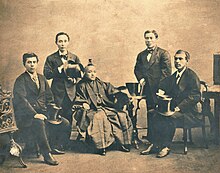| Iwakura Mission (岩倉使節団) | |
|---|---|
 Leaders of the Iwakura Mission photographed in London in 1872. L-R: Kido Takayoshi, Yamaguchi Masuka, Iwakura Tomomi, Itō Hirobumi, Ōkubo Toshimichi | |
| Ambassador | Iwakura Tomomi |
The Iwakura Mission or Iwakura Embassy (岩倉使節団, Iwakura Shisetsudan) was a Japanese diplomatic voyage to the United States and Europe conducted between 1871 and 1873 by leading statesmen and scholars of the Meiji period. It was not the only such mission, but it is the most well-known and possibly most significant in terms of its impact on the modernization of Japan after a long period of isolation from the West. The mission was first proposed by the influential Dutch missionary and engineer Guido Verbeck, based to some degree on the model of the Grand Embassy of Peter I.
The aim of the mission was threefold; to gain recognition[1] for the newly reinstated imperial dynasty under the Emperor Meiji; to begin preliminary renegotiation of the unequal treaties with the dominant world powers; and to make a comprehensive study of modern industrial, political, military and educational systems and structures in the United States and Europe.[2]
The Iwakura Mission followed several such missions previously sent by the Shogunate, such as the Japanese Embassy to the United States in 1860, the First Japanese Embassy to Europe in 1862, and the Second Japanese Embassy to Europe in 1863.
- ^ Saburō, Izumi (7 June 2019). "The Iwakura Mission: Japan's 1871 Voyage to Discover the Western World". nippon.com. Retrieved 18 June 2021.
- ^ Ruxton, Ian (1998). Nish, Ian (ed.). The Iwakura Mission to America and Europe: A New Assessment. Japan Library (Curzon Press). p. 35. ISBN 0-203-98563-X. Retrieved 3 February 2016.